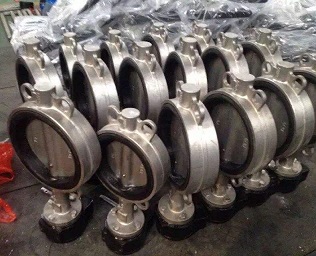Time:2022/07/26Views:147
Stainless steel and aluminum are said to be the material of the valve, stainless steel butterfly valve because of strength and corrosion resistance than aluminum alloy butterfly valve is better, generally can be used in conventional and acid-alkaline environment. The corrosion resistance of aluminum alloy butterfly valve is not good, the conduction temperature performance is good, so the material aluminum is generally used in the anti-condensation butterfly valve. Stainless steel butterfly valve (also known as stainless steel flip valve) with three eccentric multi-level metal hard seal structure, is widely used in the medium temperature ≤425℃ metallurgy, electric power, petrochemical, water supply and drainage and municipal construction and other industrial pipelines, for regulating flow and load cut-off body use. The valve adopts three eccentric structure, the valve seat and plate sealing surface are made of different hardness and stainless steel, with good corrosion resistance and long service life.
Stainless steel butterfly valves are classified by structural form
(1) Center seal butterfly valve
(2) Single eccentric sealing coal valve
(3) Double eccentric seal butterfly valve
(4) Three eccentric sealing stomp valve
Stainless steel butterfly valves are classified by sealing surface material
(1) Soft seal butterfly valve.
1) The sealing pair is composed of a non-metallic soft material to a non-metallic soft material.
2) The sealing pair is composed of metal hard material and non-metal soft material.
(2) Metal hard seal butterfly valve.
The sealing pair is composed of metal hard material to metal hard material.
Stainless steel butterfly valves are classified according to seal form
(1) Forced sealing of butterfly valve.
1) Elastic seal butterfly valve. The specific seal pressure is produced by the elasticity of the valve seat or plate when the valve plate squeezes against the valve seat when the valve is closed.
2) Additional torque seal butterfly valve. The specific seal pressure is generated by the torque applied to the valve shaft.
(2) Pressure sealing butterfly valve. The specific seal pressure is generated by pressurization of the cartridge seal element on the seat or valve plate.
(3) Automatic sealing butterfly valve. The specific sealing pressure is automatically generated by the medium pressure.

Stainless steel butterfly valves are classified according to working pressure
(1) Vacuum butterfly valve. Butterfly valve with operating pressure lower than standard reactor atmospheric calendar.
(2) Low pressure butterfly valve. Nominal pressure PN<1.6MPa butterfly valve.
(3) Medium pressure butterfly valve. The nominal pressure PN is 2.5-6.4mpa butterfly valve.
(4) High pressure disc valve. Nominal pressure PN is 10. 0-80.0mpa butterfly valve.
(5) Super high pressure butterfly valve. Nominal pressure PN>100MPa butterfly valve.
Stainless steel butterfly valves are classified according to operating temperature
(1) High temperature butterfly valve. Butterfly valves with t>450 C
(2) Medium temperature disc valve. 120 C
(3) Normal temperature butterfly valve. One 40C
(4) Low temperature butterfly valve. One hundred
(5) ultra-low temperature butterfly valve. Butterfly valves with t< 100 C
Classified by connection type
(1) Clamping butterfly valve
(2) Flange butterfly valve
(3) Support ear butterfly valve
(4) Welded butterfly valve